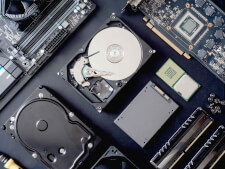Hardware
A computer's hardware consists of its physical parts, including its internal pieces and connected external devices. Hardware components perform a computer's tasks like calculating data, storing information, processing input, and providing output. Any part of a computer that you can physically touch is hardware.
All hardware devices, whether internal or external, include chips on a circuit board to perform a function. All hardware also requires a way to interface with the rest of the computer, usually by connecting to a port, socket, or wireless radio. After that, pieces of hardware will include other parts that help them fulfill their function, like buttons, sensors, protective cases, or even cooling fans to prevent overheating.
Internal Components
Internal hardware parts may also be called "components." These consist of everything inside a computer's case, including the following examples:
- A motherboard is the main system board every other component connects to, consisting of a large circuit board with many integrated chipsets and controllers. Motherboards also include sockets, slots, and ports that you can use to connect new components.
- A CPU is the brain of a computer that processes instructions and controls the rest of the hardware.
- Memory, or RAM, temporarily stores information for the CPU to process.
- Storage devices like hard drives and solid state drives hold the computer's applications and files. Unlike memory, which temporarily holds data, storage devices keep data even after the computer is powered off.
- Controller cards and expansion cards plug into special slots on a motherboard to expand a computer's capabilities. Examples include more powerful video cards, additional network interfaces, and extra ports.
- A power supply converts the alternating current from a wall socket into a direct current that powers a computer's components.
External Peripherals
External hardware devices, meanwhile, are usually called "peripherals." These include everything that connects to a computer by one of its ports or plugs, including these common examples:
- Monitors display the output of a computer's video card to provide a graphical user interface that someone can use to monitor and control the computer.
- Keyboards and mice accept input from the person operating the computer, allowing them to enter text, issue commands, and manipulate objects displayed on the screen.
- Speakers and headphones play the sounds generated by a computer.
- Printers allow a person to print a document from their computer onto paper, while scanners allow them to create a digital copy of a document or photograph. Multi-function printers that combine these functions are now common.
- External storage devices store data just like internal storage devices do, but you can easily disconnect one from one computer and reconnect to another to move data between computers.
You can add new hardware to a computer to extend its functionality. You need to turn the computer off before installing new internal components, but external peripherals are often plug-and-play. Most hardware requires drivers — data files containing instructions for the computer's operating system on how to control the new hardware — either provided on a disc bundled with the hardware or available for download from the manufacturer's website.
NOTE: While hardware refers to a computer's components, software refers to the programs and applications that run on a computer.
 Test Your Knowledge
Test Your Knowledge